We Maintain Our Hold Rating On Lowe’s Despite The Macroeconomic Headwinds (NYSE:LOW)
Justin Sullivan/Getty Images News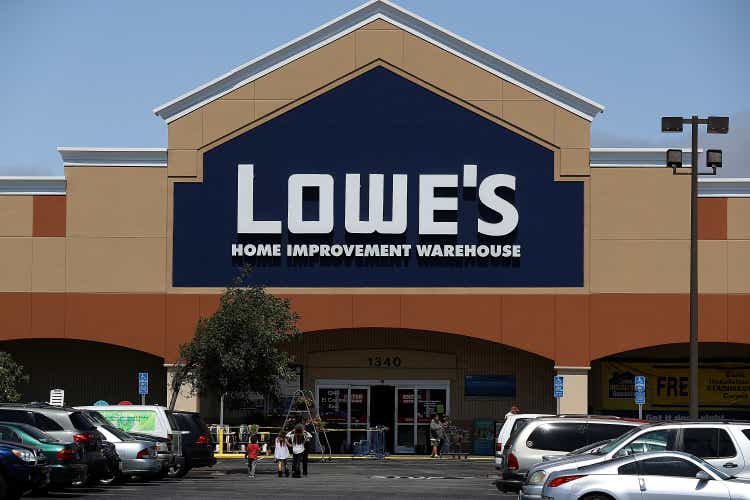
Lowe’s Companies, Inc. (NYSE:LOW) stock price has fallen more than 32% year to date, and more than 5%, since we wrote our first article on the stock.
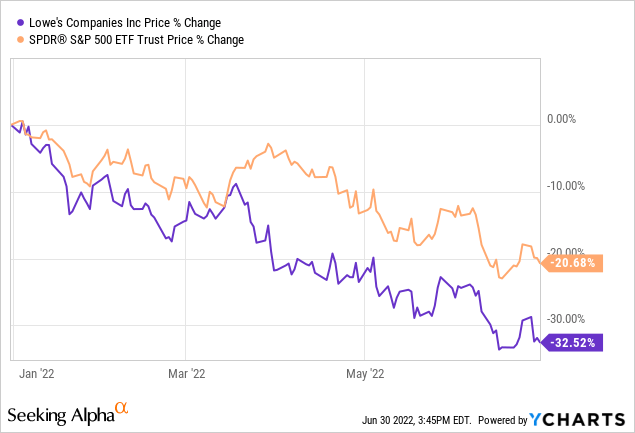
Despite the macroeconomic headwinds, we believe that LOW stock is still a hold.
In our first article, we have written extensively about the factors that we like about LOW. These factors included:
1.) strong track record of dividend payments and a sustainable yield
2.) strong track record of share buyback programs, consistent reduction of number of shares outstanding
3.) continuously expanding margins and improving return on assets
4.) solid forecasted growth
From this list, we definitely maintain our view on points 1.) and 2.).
On the other hand, we believe that due to the current macroeconomic headwinds, including elevated energy prices, elevated raw material prices, elevated freight costs, a tight labor market, supply chain disruptions, etc., it will be challenging for the firm to keep expanding its margins, at least in the near term. The geopolitical tension in the Eastern European region also does not seem ease, making the level of energy prices very uncertain in the near future.
In order to gauge, whether the forecasted growth by analysts is still reasonable, we will look at the consumer confidence, and we will study, how the firm has performed during times of low consumer confidence.
Consumer confidence
Consumer confidence is often treated as a leading economic indicator, which could signal potential trend changes in the spending behavior of the consumer in the near term.
U.S. Consumer confidence (Tradingeconomics.com)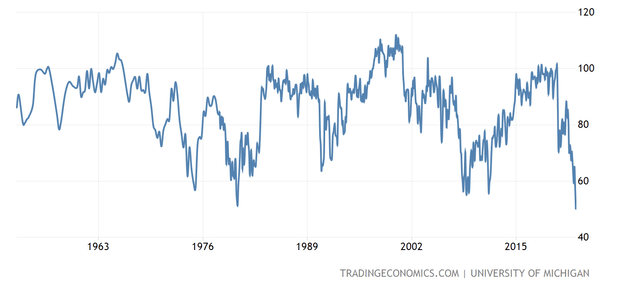
The U.S. consumer confidence has been steadily declining in the past months, falling below levels that we have seen during the financial crisis in 2008-2009. Although consumer spending has remained high so far this year, we believe that the low consumer confidence are likely to lead to significant changes in the spending behavior of the consumer.
During times of low consumer confidence, first people are likely to cut or delay their purchases of durable goods. Second, they are likely to cut their spending on non-essential, discretionary products, by either not purchasing the product at all, or by switching to lower cost alternatives.
As Lowe’s sells durable goods, we believe that the demand for their products are likely to decline in the near term, therefore there could be challenges ahead for the firm.
On the other hand, when we look at Lowe’s stock performance during a time of low consumer confidence, we can see that the firm has substantially outperformed the broader market in two out of three periods.
2001-2003
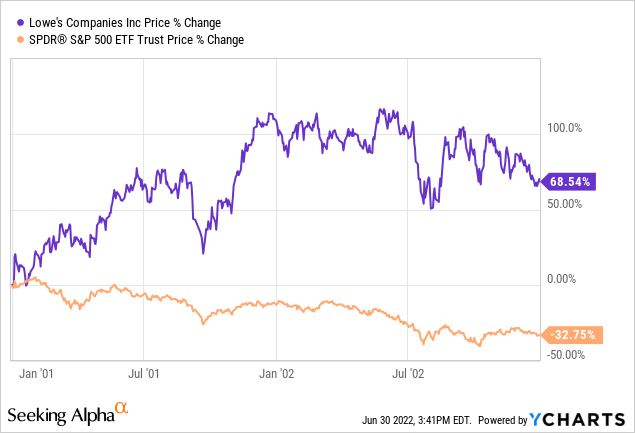
While between 2001 and 2003 the broader market (SPY) declined by more than 30%, Lowe’s stock price increased by almost 70%. In this time period, the outperformance of the firm was unquestionable.
2007-2010
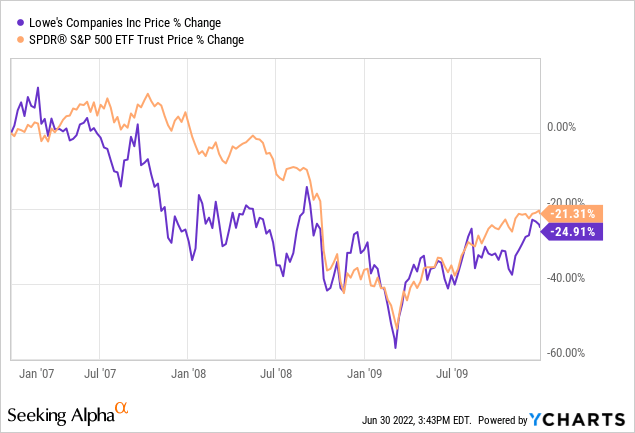
The period between 2007 and 2010 covered the financial crisis and the bursting of the housing bubble. Although initially Lowe’s underperformed the market, its performance by the end of this three year period was more or less in line with the broader market.
2011-2013
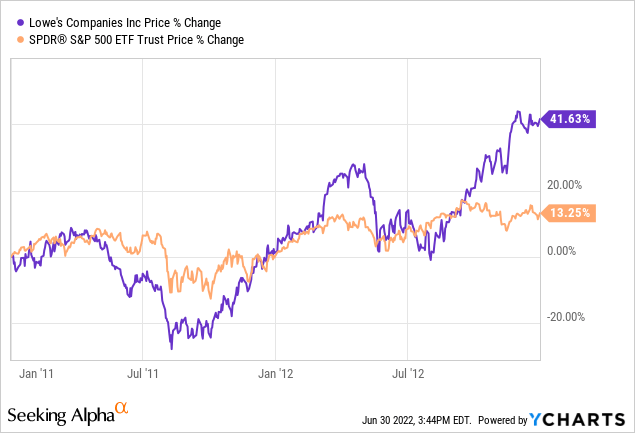
In this time frame, although both LOW and SPY saw growth, Lowe’s once again significantly outperformed the broader market, as its share price increased by more than 40%.
Although past performance is not always a reliable indicator of future performance, we believe that Lowe’s is well-positioned to perform well in the current low confidence environment, even if the previously expected growth forecast does not materialize.
Before wrapping up our article, we would like to highlight one other economic indicator, namely the number of building permits.
Building permits
The number of building permits is also considered as a leading economic indicator, which could signal the changing trends in demand for new housing units.
U.S. Building permits (Tradingeconomics.com)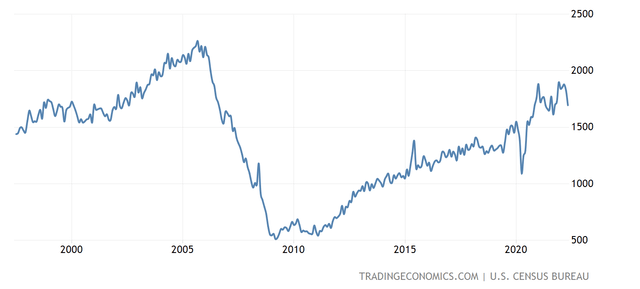
Although the number of building permits remains significantly above pre-pandemic levels, in recent months it has seen a steady decline. We believe that this could in fact indicate slowing demand for housing. This again could create headwinds and result in declining demand for Lowe’s products.
Key takeaways
We believe that Lowe’s is a great business, which could be an attractive choice for investors with long time horizons and who are interested in dividend, dividend growth and share buybacks.
In the near future, we expect the firm to face substantial macroeconomic headwinds, including elevated energy prices, elevated raw material prices, a tight labor market and supply chain disruptions, therefore we do not recommend starting a position in LOW’s stock right now.
Two leading economic indicators, consumer confidence and building permits are also signaling that the demand for Lowe’s products may become weaker in the near term.
On the other hand, when looking at the stock’s past performance during times of low consumer confidence, two out of three times the stock has substantially outperformed the broader market.
Further, in our opinion, the firm is still on track with implementing its strategic initiatives, which could have a positive impact on the margins both in the near and long term.
For these reasons, we maintain our hold rating on LOW’s stock.


